Firehouse Ruin. After canyoneering in the North Wash, Lisa goes with us to Cedar Mesa to see ruins she not seen. Our first hike is to Fire House Ruin in upper Mule Canyon along Highway 95. The hike to Fire House is only about a half mile and is one of the most visited ruins.
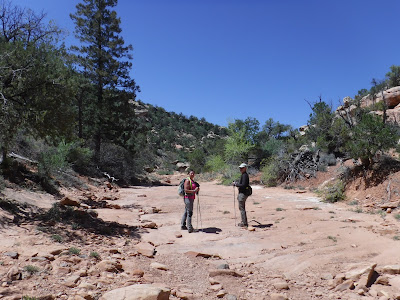 |
| Lisa and Jim hiking up Mule Canyon. |
Fire House is an eloquent dwelling molded into the fold at the top of a sloping floor. The cleavage and variegated color of the protective overhanging rock looks like flames flaring from the roof of the dwelling. Ambient mid-day light or a late afternoon glow ignite the flames for some beautiful photo opportunities. The ruin is only a little above the stream bed and accessible by a short trail.
 |
| Fire House and flames. |
Rules. Because the ruin is so accessible and open to the public everyone has the responsibility to protect it and do no harm. The basic rules are: look and don't touch. You can look in windows and doors but don't enter rooms and don't touch the walls. The dwellings are fragile and are not being stabilized. They are at the whim of time and the people who visit them. Appreciate what the early people built and leave it as you found it for others to appreciate.
 |
| Notice the large rocks on the lower section of wall and the chinking of the joints. |
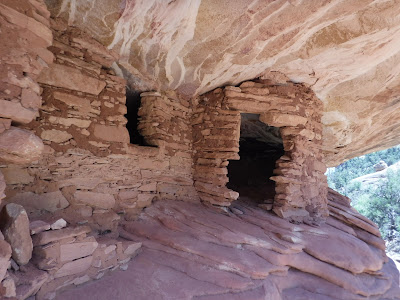 |
| Fire House. |
 |
| Jackie, Jim and Lisa on Fire House front porch. |
On a flat surface of rock under a big boulder at Fire House are four hand prints, a connection with people of the past.
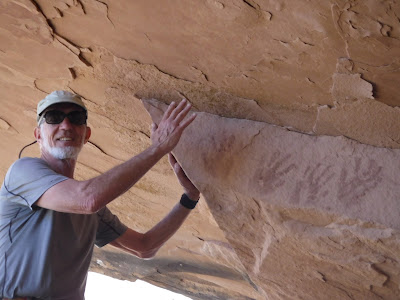 |
| Jim and handprints at Fire House. |
We hike up canyon for another couple miles and see more ruins high and inaccessible in the cliffs One of these is Wall Ruin.
 |
| Wall Ruin. |
We camp on Cedar Mesa to hike to Moon House ruin the next day. Camping on the mesa requires a day permit that is obtained at the BLM Ranger Station at Kane Gulch. A permit is also required to visit Moon House. It's the only ruin on Cedar Mesa that requires this additional special permit. The permit is free and a limited number of permits are available per day. This helps protect the ruin and gives visitors a better experience and enjoyment of the solitude that the canyon can offer.
The drive to Moon House is about 11 miles of rough, dusty, dirt road, takes about an hour and required a high clearance vehicle.
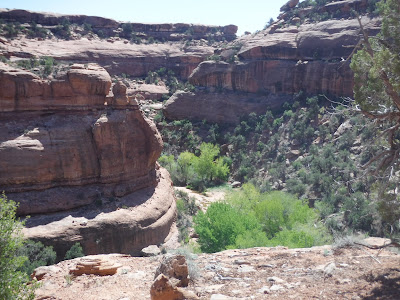 |
| Hiking to Moon House in McLoyd Canyon. |
The trail to Moon House is across slick rock that drops down from ledge to ledge to the bottom of McLoyd Canyon and then climbs up the other side to the ruin. It's not difficult but people with a fear of heights may get a bit queasy. Always take at least 2 quarts of water. Twice that if the day is hot.
 |
| Jim and Lisa on the trail to Moon House. |
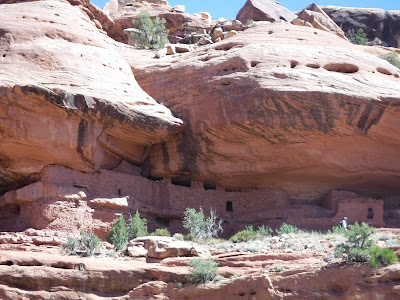 |
| Moon House. |
 |
| Jim and Lisa climb up Moon House. |
 |
| Looking up at Moon House defensive wall with loop holes to peer into the canyon below. |
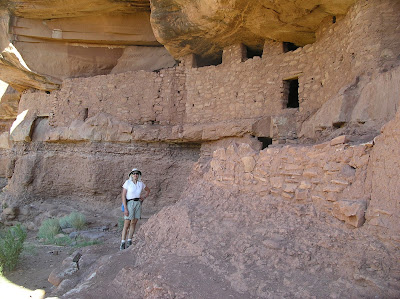 |
| Jackie at Moon House. |
 |
| Jim and Lisa on the ledge at Moon House. |
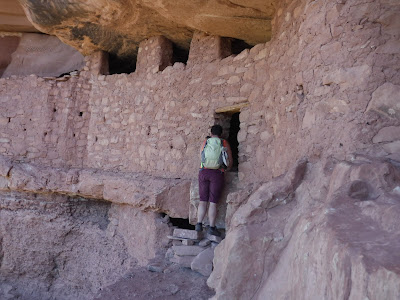 |
| Lisa at the doorway to the corridor behind the wall. |
It's permitted to enter the corridor behind the defensive wall. The easiest way is to stand on the stack of stones and sit on the sill facing outward then scoot backwards through the door.
 |
| The corridor and rooms behind the defensible wall. A white band is painted over the Moon Room door. |
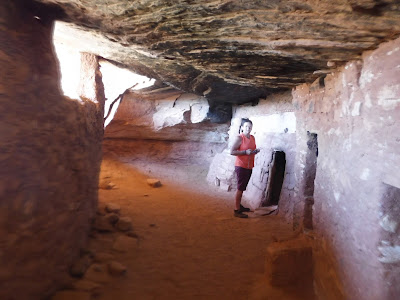 |
| Lisa at the Moon Room door in the corridor behind the defensive wall. |
Inside the corridor rooms line the back wall. You can look inside them but don't enter or touch the walls. Looking through the loop holes in the defensive wall you can see that the people who lived and took refuge here had good views of the approaches to their home.
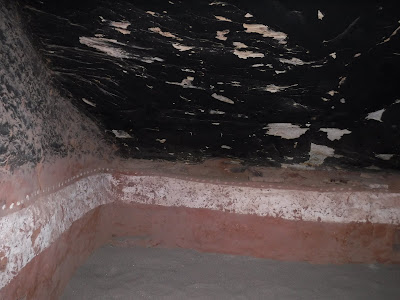 |
| The Moon Room. |
In the Moon Room a white band with white dots above it is painted around the walls. On one side within the band is a crescent moon and on the opposite wall is a full moon. The white paint was made from dolomite obtained from the canyon walls. Sand has been spread on the floor to absorb humidity to keep the fragile paint from flaking away.
 |
| The full moon in the white band in the moon room. |
The ceiling of the Moon Room was blackened by smoke from fires showing that this room was used for ceremony or living quarters.
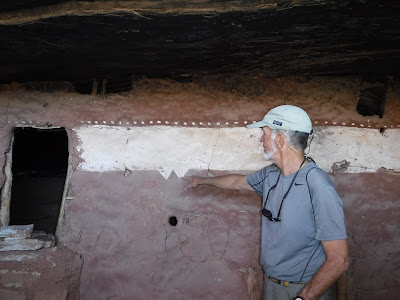 |
| Jim and wall decoration over the Moon Room door. |
A white band decorates the exterior wall over the Moon Room door. Jim speculates that the notches at the bottom of the band represent canyons cut into the flat mesa and these people may have referred to themselves as the people of the canyons. The white band could represent the big sky and the dots are stars. Who knows. Make your own story.
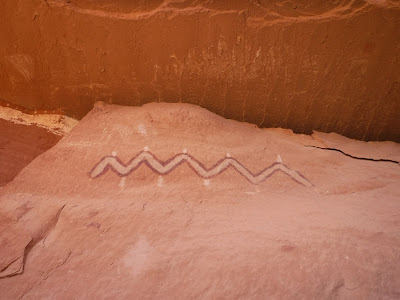 |
| A pictograph on the cliff above Moon House. |
Is the pictograph above Moon House a snake, a water symbol, a clan sign?
 |
| The wattle and dab construction next to Moon House. |
We walk the ledge going east down canyon for about a quarter mile until it gives way to cliff face. There are many rooms and granaries to be seen along the way.
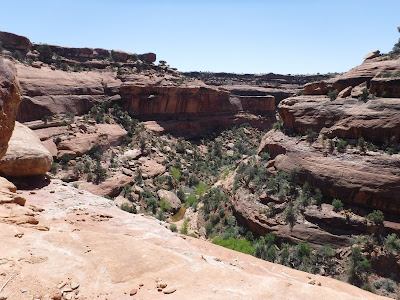 |
| Looking into McLoyd Canyon from the end of the traversable section of the ledge. |
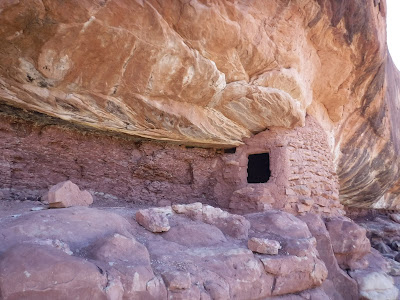 |
| One of the granaries on the ledge. |
 |
| Jim and Lisa stand at a row storage rooms at the far end of the ledge from Moon House. |
 |
| The storage rooms are very nicely constructed. |
 |
| Storage rooms. |
 |
| Another granary along the ledge. |
We return to Moon House and follow the ledge up canyon to the west. On the west end of Moon House are the remains of timbers that may have been part of a floor for a second story in an alcove in the cliff.
 |
| Timbers from what may have been a floor. |
We continue to follow the ledge until we have to drop down to a lower level to get to a kiva and small ruin.
 |
| Jim and a fellow hiker at the kiva up canyon from Moon House. |
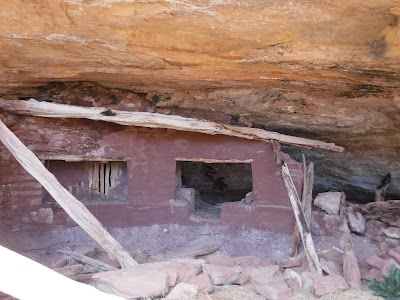 |
| The remnants of the kiva show it was well constructed. The interior was painted an earth red. |
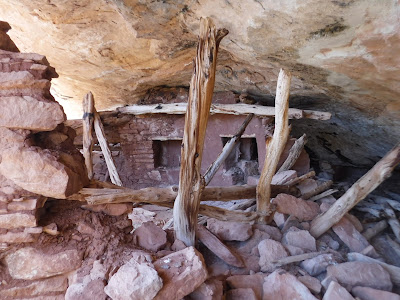 |
| Looking into the kiva through timbers and fallen walls. |
On the same ledge as the kiva is a small ruin with an interesting and very personal decoration.
 |
| The small dwelling near the kiva. |
 |
| A wattle and dab constructed room attached to the dwelling. |
The unusual feature of this ruin are the baby feet impressions that were pressed into the mud mortar on each side of the door. You can count the toes. The parents must have held the little feet together and pressed them into the wet mud. They speak to us of their hope for their families future.
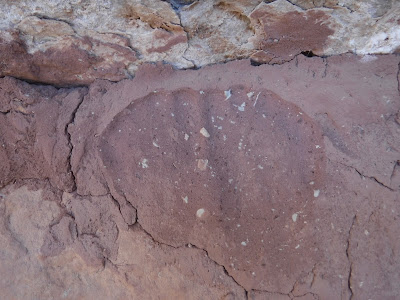 |
| Baby feet impressions on the left side of the door. |
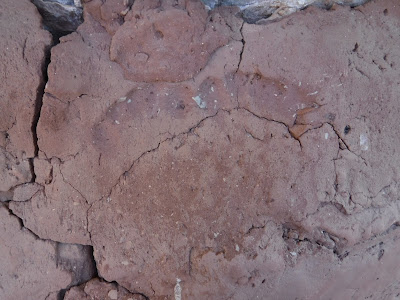 |
| Baby feet impressions on the right side of the door. |
 |
| In this photo you can see the baby feet impression on the left side of the door above the oval shaped rock near the top of the wall. You can also just barely see the other set of feet impressions at the upper right corner of the door. |
There are more ruins up canyon but we call it a day and hike back to the canyon rim in the late afternoon. The next day we say our farewell to our friend and head for home.
This was just a short adventure, on Cedar Mesa, in the Bears Ears National Monument. There are many more adventures to be had by everyone as long as the Monument protection holds. It is surely worthy of this protection and your support.
Our next travels will begin in July. Join us for more adventures.
Until then,
Jackie